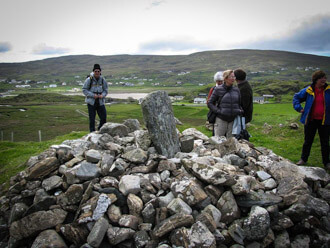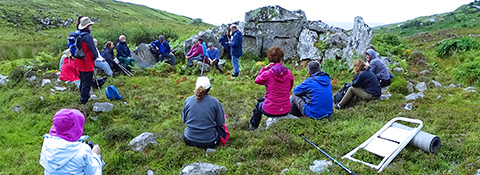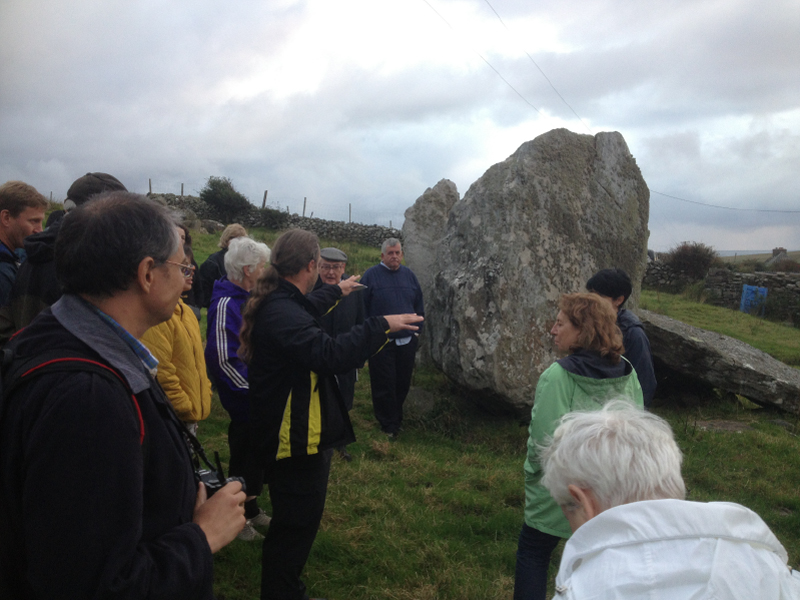Archaeology
In recent years the curriculum of the annual Fr. James MacDyer Archaeology School, now in existence for over 40 years, focuses on attracting the new participants as well as those students who wish to return to study in greater depth.
| Title | Location | Price | |
|
Saturday, 2 August 2025 — Saturday, 9 August 2025
|
|||
| Archaeology FULL! | Gleann Cholm Cille | €210 | Book now |
Gleann Cholm Cille (The Valley of St Columba) and the nearby valleys in southwest Donegal contain some of the most interesting prehistoric and early historic structures in Ireland (some would argue, in Europe). Monuments from the early Neolithic (c. 4000BC) onwards are dotted across this beautiful and informative landscape; among them the huge dolmens at Malinmore and the great court-tombs at Clochán Mór and Farranmacbride. The previous name of the valley – Senglenn ('the old glen') – was very apt.
In medieval times (roughly AD500-1600) that name was changed to honour one of Ireland's best-loved saints: Colmcille (in Irish) or Columba (in Latin). Legends and folkore claim that the saint (c. AD520-593) came to the valley and founded a church there. An important legacy from that Christianisation is the surviving cluster of stone cross-slabs (some probably dating to around AD800) and other early ecclesiastical features around the valley. Another legacy is the famous turas ('pilgrimage') made around those sites; primarily on 9 June, the day the saint died – his feast-day.
This Summer School, based in such an appropriate location, is aimed at adults with an interest in the archaeology and ancient history of Ireland. No previous knowledge is required; merely a curiosity and a willingness to participate in outdoor sessions, studying the evidence of the monuments in their landscape context. Apart from the local monuments, the course will provide an introduction to the archaeology of Ireland in general.
The sites to be visited raise a number of sub-themes which will be pursued also in the discussions and lectures: (i) how the visible landscape is a 'text' to be read; (ii) the process of 'conversion' by which pagan Celtic Ireland became a vibrant Christian culture; (iii) the ethical and practical problems associated with the conservation and 'restoring' of ancient monuments or leaving them as 'ruins'; and (iv) the degree to which the archaeology of the ancient world contributes evidence to the current debate on climate change.
Normally, day-time sessions are held outdoors at the monuments, with occasional visits to sites outside the glen. There'll also be various evening activities – especially a number of background lectures – and, of course, time to enjoy the other attractions for which the glen is famous.
Please note: Participants are advised to have proper rain-gear and strong walking boots.
Archaeology Summer School 2025
Work is underway on this year's programme. See the 2024 programme below as an illustration of the course timetable.
SaturdayIntroduction
SundayShort introductory walk — 'reading the landscape'
Lecture: 'Gleann Cholm Cille in the context of Irish archaeology'
MondayAmuigh faoin aer – visits to local prehistoric (Neolithic) burial monuments (10:00-17:00)
Participants (divided into small teams) will be asked to undertake some basic archaeological tasks as an introduction to field research.
TuesdayAll day tour to Gartan - visits to sites connected with the birth, and life as a child, of St Colmcille.
WednesdayDay-long tour to sites outside the valley: Kilclooney, Inishkeel, Kilrean, etc. (10:00-18:00)
Choice of sites will depend on local tides/weather
ThursdaySite visits (10:00-15:00)
Visits to sites near Gleann Cholm Cille: Carrick, Kilcar, Shalwy valley, Killaghtee, St John’s Point.
Illustrated lecture by Dr Brian Lacey: 'The 1400th anniversary of the birth of Adomnán – one of the most important persons from Donegal of the early middle ages' (19:30-21:00)
FridaySite visits (10:00-15:00)
Visit to Gleann Cholm Cille Folk Village to compare the post-medieval traditional structures there with prehistoric/medieval houses/settlements. Also, a walking tour of some of the 'stations' of Turas Cholm Cille with an introduction to the story of St Colmcille, the patron of the valley.
Debriefing session — 'What did we learn this week?' (16:00-17:00)
Course Instructors
The 2025 Summer School is directed by Dr Brian Lacey who has been researching the archaeology and early history of Counties Donegal and Derry for over 40 years. A former university lecturer and museum director in Derry, he oversaw the archaeological survey of Donegal (1979-83). From 1998 to 2012 he was CEO of the Discovery Programme, an institute for advanced research in Irish archaeology. His particular specialism is the lore of St Colmcille. He has published 15 books and many research papers. Assisting will be Paula Harvey who has been working in archaeology also for over 40 years. A former lecturer in Dún Laoghaire, Co. Dublin, she was previously County Museum Curator and Field Monument Advisor for Donegal County Council. Paula has worked on many heritage-related projects both in Donegal and elsewhere. She is chair of Donegal GAP Heritage and History Group with the conservation of Doon Fort, part of the Heritage Council’s Adopt a Monument Ireland scheme, as their flagship project.
Background to the Summer School
The Gleann Cholm Cille archaeology summer school was established in 1973 by Fr James McDyer with Prof. Michael Herity, University College Dublin, acting as director. Fr McDyer extolled the abundance of archaeological riches in Donegal thus: ‘Rarely has the uncouth hand been raised to deface the monuments here. Never has the march of progress been allowed to brush them irreverently aside’. Prof. Herity served as director until 2015. He sadly passed away on 22 January 2016. ‘Suaimhneas síoraí ar a anam’.



